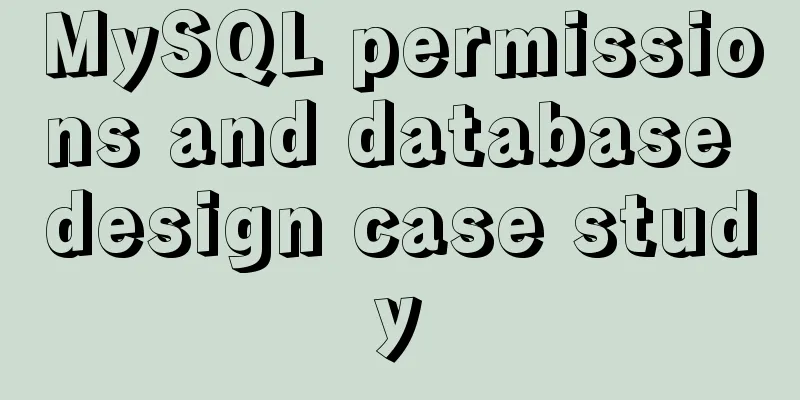MySQL permissions and database design case study

|
Permissions and database design User Management
/* User and permission management */ ------------------
User information table: mysql.user
-- FLUSH PRIVILEGES
-- Add user CREATE USER kuangshen IDENTIFIED BY '123456'
CREATE USER username IDENTIFIED BY [PASSWORD] password (string)
- You must have the global CREATE USER privilege for the mysql database, or have the INSERT privilege.
- Can only create users, cannot grant permissions.
- Username, note the quotes: e.g. 'user_name'@'192.168.1.1'
- The password also needs to be quoted, and pure numeric passwords also need to be quoted - To specify the password in plain text, omit the PASSWORD keyword. To specify the password as a hashed value returned by the PASSWORD() function, include the keyword PASSWORD.
-- Rename user RENAME USER kuangshen TO kuangshen2
RENAME USER old_user TO new_user
-- Set password SET PASSWORD = PASSWORD('password') -- Set password for current user SET PASSWORD FOR username = PASSWORD('password') -- Set password for specified user -- Delete user DROP USER kuangshen2
DROP USER username -- assign permissions/add users GRANT permission list ON table name TO username [IDENTIFIED BY [PASSWORD] 'password']
- all privileges means all privileges - *.* means all tables in all libraries - library name.table name means a table under a library - View permissions SHOW GRANTS FOR root@localhost;
SHOW GRANTS FOR username - view the current user permissions SHOW GRANTS; or SHOW GRANTS FOR CURRENT_USER; or SHOW GRANTS FOR CURRENT_USER();
-- Revoke permissions REVOKE permission list ON table name FROM user name REVOKE ALL PRIVILEGES, GRANT OPTION FROM user name -- Revoke all permissions
-- Privilege list ALL [PRIVILEGES] -- Set all simple privileges except GRANT OPTION ALTER -- Allow use of ALTER TABLE
ALTER ROUTINE -- change or delete a stored procedure CREATE -- enable use of CREATE TABLE
CREATE ROUTINE -- create a stored routine CREATE TEMPORARY TABLES -- allow use of CREATE TEMPORARY TABLE
CREATE USER -- Enables use of CREATE USER, DROP USER, RENAME USER, and REVOKE ALL PRIVILEGES.
CREATE VIEW -- Allows the use of CREATE VIEW
DELETE -- Allows the use of DELETE
DROP -- Allows the use of DROP TABLE
EXECUTE -- Allows the user to run a stored procedure FILE -- Allows the use of SELECT ... INTO OUTFILE and LOAD DATA INFILE
INDEX -- Allows use of CREATE INDEX and DROP INDEX
INSERT -- Allows the use of INSERT
LOCK TABLES -- Allows you to use LOCK TABLES on tables for which you have SELECT privileges.
PROCESS -- Enable use of SHOW FULL PROCESSLIST
REFERENCES -- not implemented RELOAD -- FLUSH is allowed
REPLICATION CLIENT -- allows the user to ask for the address of a slave or master server REPLICATION SLAVE -- for replication slave servers (reading binary log events from the master server)
SELECT -- Allows the use of SELECT
SHOW DATABASES -- Displays all databases SHOW VIEW -- Enables the use of SHOW CREATE VIEW
SHUTDOWN -- allow use of mysqladmin shutdown
SUPER -- Enables use of CHANGE MASTER , KILL , PURGE MASTER LOGS , and SET GLOBAL statements, and the mysqladmin debug command; allows you to connect (once) even if max_connections has been reached.
UPDATE -- Allows the use of UPDATE
USAGE -- Synonym for "no privileges" GRANT OPTION -- Allow granting of privileges /* Table maintenance */
--Analyze and store the keyword distribution of the table ANALYZE [LOCAL | NO_WRITE_TO_BINLOG] TABLE table name...
-- Check one or more tables for errors CHECK TABLE tbl_name [, tbl_name] ... [option] ...
option = {QUICK | FAST | MEDIUM | EXTENDED | CHANGED}
-- Defragment the data file OPTIMIZE [LOCAL | NO_WRITE_TO_BINLOG] TABLE tbl_name [, tbl_name] ...MySQL backupNecessity of database backup
MySQL database backup method
mysqldump client effect:
-- Export 1. Export a table -- mysqldump -uroot -p123456 school student >D:/a.sql mysqldump -u username -p password database name table name > file name (D:/a.sql) 2. Export multiple tables -- mysqldump -uroot -p123456 school student result >D:/a.sql mysqldump -u username -p password database name table 1 table 2 table 3 > file name (D:/a.sql) 3. Export all tables --mysqldump -uroot -p123456 school >D:/a.sql mysqldump -u username -p password database name > file name (D:/a.sql) 4. Export a library -- mysqldump -uroot -p123456 -B school >D:/a.sql mysqldump -u username -p password -B database name > file name (D:/a.sql) You can use -w to carry backup conditions -- Import 1. When logging in to mysql: -- source D:/a.sql source backup file 2. Without logging in, mysql -u username -p password database name < backup file Normalized database designWhy do we need database design?When the database is complex, we need to design the database Bad database design:
Good database design:
Database design in software project development cycle:
Steps to design a database
Three paradigmsQuestion: Why is data normalization necessary? Problems caused by improper table design:
First Normal Form (1st NF) The goal of the first paradigm is to ensure the atomicity of each column. If each column is the smallest indivisible data unit, the first paradigm is satisfied. Second Normal Form (2nd NF) The second normal form (2NF) is built on the basis of the first normal form (1NF), that is, to satisfy the second normal form (2NF), the first normal form (1NF) must be satisfied first. The second paradigm requires that each table only describes one thing Third Normal Form (3rd NF) A relation is in third normal form if it is in second normal form and no columns other than the primary key are transitively dependent on the primary key columns. The third paradigm requires ensuring that each column of data in the data table is directly related to the primary key, and not indirectly related. The relationship between normalization and performance To meet certain business goals, database performance is more important than normalizing the database When normalizing data, the performance of the database should be considered comprehensively. By adding additional fields to a given table, you can significantly reduce the time required to search for information in it. By inserting calculated columns into a given table, it is easier to query
This is the end of this article about MySQL permissions and database design cases. For more information about MySQL permissions and database design, please search for previous articles on 123WORDPRESS.COM or continue to browse the following related articles. I hope you will support 123WORDPRESS.COM in the future! You may also be interested in:
|
<<: Podman boots up the container automatically and compares it with Docker
>>: Pure CSS to achieve left and right drag to change the layout size
Recommend
Detailed explanation of mysql scheduled tasks (event events)
1. Brief introduction of the event An event is a ...
Detailed explanation of the installation and use of Linux scheduled tasks crontabs
Install crontab yum install crontabs CentOS 7 com...
Detailed steps to install a virtual machine and use CentOS 8 using VMware 15
Preface: I'm currently learning Linux and .Ne...
A Brief Analysis of Patroni in Docker Containers
Table of contents Create an image File Structure ...
In-depth explanation of the locking mechanism in MySQL InnoDB
Written in front A database is essentially a shar...
MySQL time difference functions (TIMESTAMPDIFF, DATEDIFF), date conversion calculation functions (date_add, day, date_format, str_to_date)
1. Time difference functions (TIMESTAMPDIFF, DATE...
CSS World--Code Practice: Image Alt Information Presentation
Using the <img> element with the default sr...
Example of automatic import method of vue3.0 common components
1. Prerequisites We use the require.context metho...
React event binding details
Table of contents Class component event binding F...
MySQL string splitting operation (string interception containing separators)
String extraction without delimiters Question Req...
Vue implements adding watermark to uploaded pictures
This article shares the specific implementation c...
MySQL efficient query left join and group by (plus index)
mysql efficient query MySQL sacrifices group by t...
HTML realizes real-time monitoring function of Hikvision camera
Recently the company has arranged to do some CCFA...
Vue mobile terminal realizes the whole process of left sliding editing and deletion
Preface According to the project needs, Vue-touch...
Solution to the CSS height collapse problem
1. High degree of collapse In the document flow, ...












